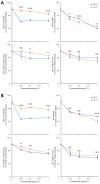Volatile and Non-Volatile Allelopathic Characteristics in Thermally Processed Needles of Two Conifers
- PMID: 35448731
- PMCID: PMC9031333
- DOI: 10.3390/plants11081003
Volatile and Non-Volatile Allelopathic Characteristics in Thermally Processed Needles of Two Conifers
Abstract
With allelopathic composts, potential merits for preventing initial weed infestations have been observed in crop transplantation. However, previous studies have rarely investigated whether high temperatures, generated during composting, decrease allelopathic ability. This study evaluated the thermal allelopathic effect of two coniferous plants (Pinus densiflora and P. koraiensis) on Brassica napus germination and seedling growth using their characterized allelochemical destinations. The 90 °C dry treatment of P. densiflora extract exhibited stronger inhibitory effect on germination than its 30 °C dry treatment. In a range from 0.25 to 1 mg mL-1, the germination rate was decreased to 38.1 and 64.3% of control with P. densiflora extract dried at 90 and 30 °C, respectively. However, P. koraiensis showed potent inhibition of the germination process with no statistical difference in inhibitory effects regardless of the dry temperature. Regarding B. napus seedling root growth, the allelopathic effects of aqueous extracts of both conifers were not reduced with the 90 °C treatment, but it was lost in seedling shoot growth. GC-MS/MS confirmed that high temperature treatment drastically decreased volatile contents to 53.2% in P. densiflora, resulting in reduced allelopathic abilities. However, a relatively lower decrease to 83.1% in volatiles of P. koraiensis accounts for less loss of the root-specific inhibitory effect on B. napus seedlings even after 90 °C treatment. Foliar tissues of both conifers with species-specific thermal resistance have potentially valuable functions regarding allelopathic use in horticultural compost processing ingredients, demonstrating their weed control ability during the early cultivation season where crops are transplanted in the facilitated area.
Keywords: Pinus densiflora; Pinus koraiensis; allelopathy; bioherbicides; compost processing; coniferous volatiles; thermal resistance.
Conflict of interest statement
The authors declare no conflict of interest.
Figures






References
-
- Ghimire B., Lee C., Yang J., Heo K. Comparative leaf anatomy of native and cultivated Pinus (Pinaceae) in Korea: Implication for the subgeneric classification. Plant Syst. Evol. 2015;301:531–540. doi: 10.1007/s00606-014-1090-0. - DOI
-
- Fahad S., Hussain S., Chauhan B.S., Saud S., Wu C., Hassan S., Tanveer M., Jan A., Huang J. Weed growth and crop yield loss in wheat as influenced by row spacing and weed emergence times. Crop Prot. 2015;71:101–108. doi: 10.1016/j.cropro.2015.02.005. - DOI
-
- Doğan M.N., Jabran K., Unay A. Integrated Weed Management in Cotton. In: Chauhan B.S., Mahajan G., editors. Recent Advances in Weed Management. Springer; New York, NY, USA: 2014. pp. 197–222. - DOI
-
- Guimarães Santos C.A., Silva G.B.L. Daily streamflow forecasting using a wavelet transform and artificial neural network hybrid models. Hydrol. Sci. J. 2014;59:312–324. doi: 10.1080/02626667.2013.800944. - DOI
-
- Bhadoria P. Allelopathy: A natural way towards weed management. Am. J. Exp. Agric. 2011;1:7–20. doi: 10.9734/AJEA/2011/002. - DOI
Grants and funding
LinkOut - more resources
Full Text Sources
Miscellaneous

